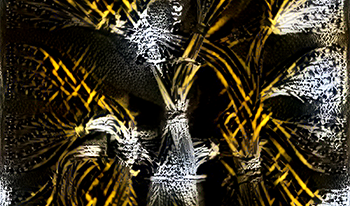References
1AdadiA.BerradaM.2018Peeking inside the black-box: a survey on explainable artificial intelligence (XAI)IEEE Access6521385216052138–6010.1109/ACCESS.2018.2870052
2
3ArcasB. A. y.Art in the age of machine intelligenceArtists and Machine Intelligence2016
4AugustinM. D.LederH.HutzlerF.CarbonC.-C.2008Style follows content: On the microgenesis of art perceptionActa Psychologica128127138127–3810.1016/j.actpsy.2007.11.006
5AugustinM. D.DefranceschiB.FuchsH. K.CarbonC.-C.HutzlerF.2011The neural time course of art perception: An ERP study on the processing of style versus content in artNeuropsychologia49207120812071–8110.1016/j.neuropsychologia.2011.03.038
6BelkeB.LederH.CarbonC.-C.
7BerryD. M.Critical Theory and the Digital2014Bloomsbury AcademicNew York and London
8CrowtherP.
9CrowtherP.Conditions of creativity: drawing and painting with computersin What Drawing and Painting Really Mean: The Phenomenology of Image and Gesture2017RoutledgeNew York, NY132153132–53
10ClarkA.2013Whatever next? Predictive brains, situated agents, and the future of cognitive scienceBehav. Brain Sci.36181204181–20410.1017/S0140525X12000477
11DaveyN.DaviesS.HigginsK. M.HopkinsR.SteckerR.CooperD. E.Alexander BaumgartenA Companion to Aesthetics2009John Wiley & SonsHoboken, UK404140–1
12EcoU.
13ErnstM.Max Ernst: Beyond Painting2009Wittenborn, SchultzNew York, NY
14GamboniD.Potential Images: Ambiguity and Indeterminacy in Modern Art2002Reaktion BooksLondon
15GallisonP.LatourB.WeibelP.Images scatter into dataData gather into ImagesICONOCLASH: Beyond the image wars in science, religion, and art, ZKM Center for Art and Media2002MIT Press Karlsruhe300323300–23
16GatysL. A.EckerA. S.BethgeM.
17GhahramaniZ.2015Probabilistic machine learning and artificial intelligenceNature521452459452–910.1038/nature14541
18GombrichE. H.Art and Illusion: A Study in the Psychology of Pictorial Representation1989Princeton University PressPrinceton, NJ
19GoodingM.Abstract Art2001Tate PublishingLondon
20GoodfellowI.BengioY.CourvilleA.Deep Learning2016MIT PressCambrdge, MA
21GoodfellowI. J.Pouget-AbadieJeanMirzaMehdiXuBingWarde-FarleyDavidOzairSherjilCourvilleAaronBengioYoshuaGenerative adversarial netsProc. IS&T’s NIP142014IS&TSpringfield, VA
22GoldfarbL.GayD.GolubitskyO.KorkinD.ScrimgerI.
23GoebelR.ChanderA.HolzingerK.LecueF.AkataZ.StumpfS.KiesebergP.HolzingerA.HolzingerA.KiesebergP.TjoaA. M.WeipplE.Explainable AI: the new 42?Machine Learning and Knowledge Extraction2018Springer International Publishing AGCham, Switzerland295303295–303
24GombrichE. H.The Sense of Order: A Study in the Psychology of Decorative Art1984PhaidonLondon
25GunningD.AhaD.2019DARPA’s explainable artificial intelligence (XAI) programAI Magazine40445844–58
26HendersonS. G.NelsonB. L.HendersonS. G.NelsonB. L.Chapter 1: Stochastic computer simulationHandbooks in Operations Research and Management Science2006Vol. 13ElsevierAmsterdam, the Netherlands1181–18
27HessT. B.Abstract Painting: Background and American Phase1951Viking PressNew York
28IhdeD.Technology and the Lifeworld: From Garden to Earth1990Indiana University PressBloomington and Indianapolis
29IshaiA.FairhallS. L.PepperellR.
30IsolaP.ZhuJ.-Y.ZhouT.EfrosA. A.
31JaglomH.SquireJ. E.The independent filmmakerThe Movie Business Book19922nd. ed.Fireside (Simon & Schuster)New York, NY748174–81
32KleeneS. C.ShannonC. E.McCarthyJ.Representation of events in nerve nets and finite automataAutomata StudiesAnnals of Mathematics Studies1956Vol. 34Princeton University PressPrinceton, NJ3423–42
33KuhnT. S.The Structure of Scientific Revolutions1962University of Chicago PressChicago, IL, USA64
34LaingC.LordG. J.Stochastic Methods in Neuroscience2010Oxford University PressOxford
35LeCunY.BengioY.HintonG.
36MargolisJ.What, After All, is a Work of Art?, Lectures in the Philosophy of Art1999Pennsylvania State University PressUniversity Park, Pennsylvania
37McCarthyJ.MinskyM.RochesterN.ShannonC. E.
38McCaigG.DiPaolaS.
39
40MillerA. I.The Artist in the Machine: The World of AI-Powered Creativity2019MIT PressCambridge, MA
41MitchellT. M.Machine Learning1997McGraw-HillNew York and London
42MordvintsevA.OlahC.TykaM.Inceptionism: going deeper into neural networksGoogle AI Research Blog2015
43MoszynskaA.Abstract Art1990Thames and HudsonLondon, UK
44MuthC.CarbonC.-C.
45MuthC.CarbonC.-C.
46MuthC.HesslingerV. M.CarbonC.-C.
47NadinM.
48NadinM.IantovicsB.KountchevR.Quantifying anticipatory characteristics. The anticipationscopeTM and the anticipatory profileTMAdvanced Intelligent Computational Technologies and Decision Support Systems2014Springer International PublishingCham, Switzerland143160143–60
49NamuthH.
50
51OrtliebS. A.KügelW. A.CarbonC.-C.2020Fechner (1866): The aesthetic association principle—a commented translationI-Perception1110.1080/03081079.2011.622093
52PaulC.New Media in the White Cube and Beyond: Curatorial Models for Digital Art2008University of California PressBerkeley, CA
53PolanyiM.The Tacit Dimension1966Doubleday & Co.Garden City, NY
54RediesC.
55RumelhartD. E.HintonG. E.WilliamsR. J.1986Learning representations by back-propagating errorsNature323533536533–610.1177/2041669520920309
56RussellS.NorvigP.Artificial Intelligence: A Modern Approach1995Prentice HallUpper Saddle River, NJ
57SeeleyW. P.2006Naturalizing aesthetics: art and the cognitive neuroscience of visionJ. Visual Art Practice5195213195–213
58SiegelJ.Adolph Gottlieb at 70ARTnews1973Vol. 72The Art FoundationNew York, NY575957–9
59SnowC. P.The Two Cultures1959Cambridge University PressNew York, NY
60SprattE. L.
61SpiesW.Max Ernst: Life and Work2006Thames & HudsonLondon
62SzékelyT.BurrageK.2014Stochastic simulation in systems biologyComputat. Struct. Biotechnol. J.142514–25
63TöyryläH.
64VarnedoeK.Pictures of Nothing: Abstract Art Since Pollock2006Princeton University PressPrinceton and Oxford
65VarnedoeK.
66WagemansJ.2011Towards a new kind of experimental psycho-aesthetics? Reflections on the parallellepipeda projectI-Perception2648678648–7810.1016/j.csbj.2014.10.003
67WangX.BylinskiiZ.HertzmannA.PepperellR.
68

 Find this author on Google Scholar
Find this author on Google Scholar Find this author on PubMed
Find this author on PubMed